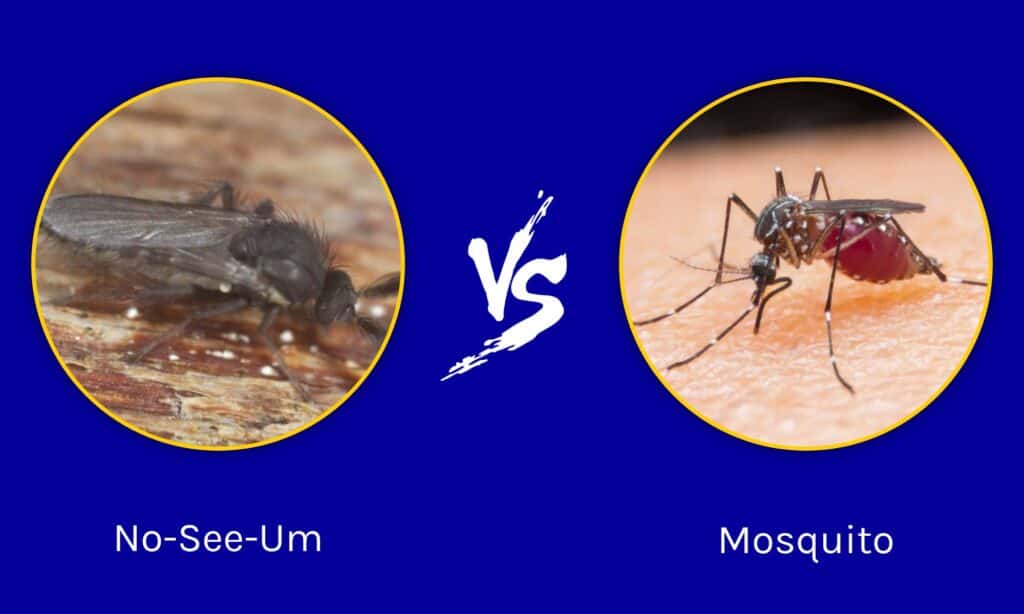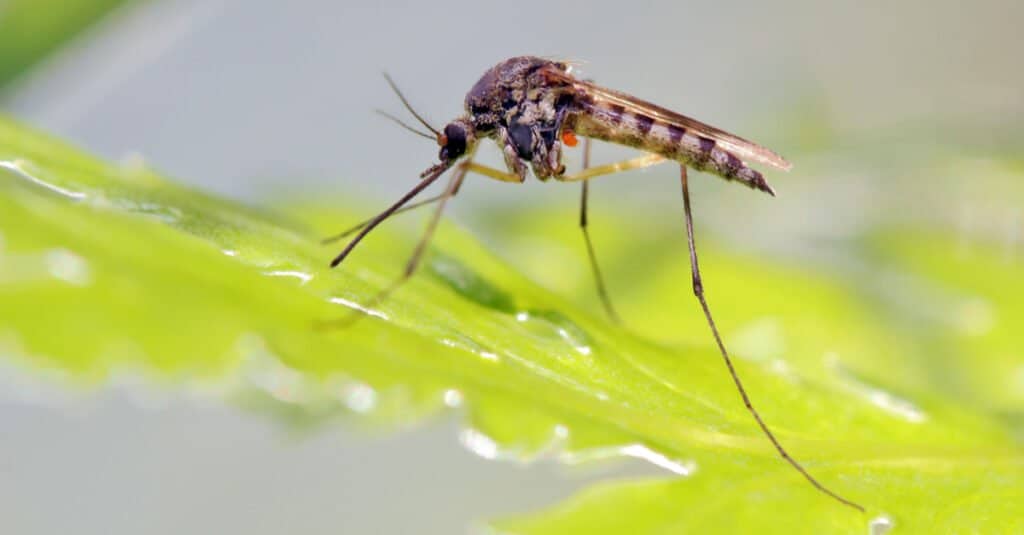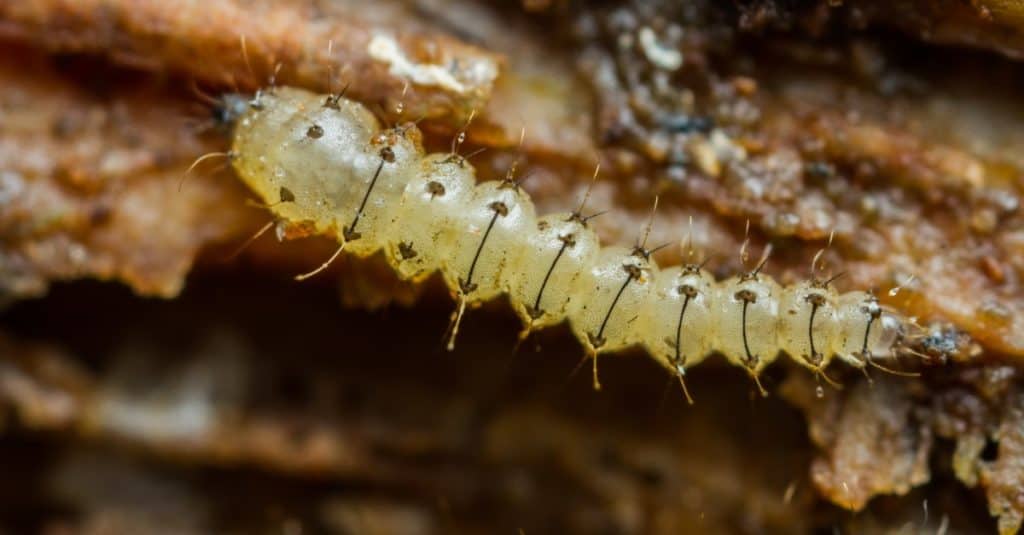We’ve all encountered pesky biting insects, but have you ever wondered just what it is that’s biting you? Two of the best-known biting insects are mosquitoes and no-see-ums (also known as biting midges). Both mosquitoes and no-see-ums are widespread worldwide and typically lay their eggs in and around water sources. But how do we tell them apart? As it turns out, there are quite a few differences that we can use to distinguish the two – including which one hurts the most. So join us as we discover everything you need to know about no-see-um vs mosquito!
Comparing Mosquito vs No-See-Um

| No-See-Um | Mosquito | |
|---|---|---|
| Distribution | Everywhere except Antarctica and the Arctic | Everywhere except Antarctica |
| Size | 0.04 – 0.12 inches long | 0.15 – 0.7 inches long |
| Mouthpart | Saw-like cutting edges | Needle-like |
| Color | Grey | Grey, often with white stripes across the abdomen. |
| Wings | Covered with dense hair | Covered with green, blue, white, or silver scales |
| Legs | Shorter, don’t dangle | Long, dangle in flight |
| Eggs | Up to 450 | 100 – 200 |
| Larvae | Aquatic and terrestrial | Aquatic |
| Predators | Larger insects, birds, carnivorous plants | Fish (especially mosquito fish), birds, bats, dragonflies, damselflies |
| Lifespan | 2 – 6 weeks | Male – up to 10 days Females – average 6 weeks |
The 5 Key Differences Between No-See-Ums and Mosquitoes
The key differences between no-see-ums and mosquitoes include size, distribution, appearance, mouthparts, wings, and larvae survival.
Mosquitoes and no-see-ums are both flying insects that are best known for their ability to bite and feed on blood. There are more than 3,500 species of mosquitoes in the world within the Culicidae family group. However, there are more than 5,000 species of no-see-ums that are all members of the Ceratopogonidae family group.
No-See-Um vs Mosquito: Size

Mosquitoes are much larger than no-see-ums.
©Achkin/Shutterstock.com
One of the main differences between mosquitoes and no-see-ums is their size. No-see-ums are tiny – so small that you can barely even see them most of the time (which is also where they get their name from). No-see-ums vary between only 0.04 and 0.12 inches long. However, mosquitoes range between 0.15 and 0.7 inches long. Although they are of a similar shape, the greater size of mosquitoes gives them a longer, more elongated body than no-see-ums.
No-See-Um vs Mosquito: Mouthpart
There’s nothing quite like the pain of a mosquito or no-see-um bite, but have you ever wondered just why they hurt so much? Well, it’s all down to their mouthparts! Mosquitoes are pretty well known for their mouthpart, which is a unique series of needle-like structures that they use to puncture the skin. Once they’ve punctured the skin, they are able to find a blood vessel and literally just suck the blood straight out.
However, despite their tiny size, no-see-ums have a reputation for having more painful bites than mosquitoes. The reason for this is that they have a different mouthpart to mosquitoes. Rather than puncturing the skin, no-see-ums literally cut it open. They do this using their saw-like mandibles, which is why it hurts so much. After cutting the skin open, no-see-ums then injects saliva underneath the skin, which causes the blood to pool there (and creates the raised bump on the skin). They then suck up the blood using their proboscis, similar to the mosquitoes’ needle-like structure.
No-See-Um vs Mosquito: Appearance
Although no-see-ums are absolutely tiny and are therefore incredibly difficult to even see, they are grey, and their wings are covered with thick, dense hair. It often looks as though their wings are covered in many tiny patterns, but this is actually just the pigmentation in the wings that makes it appear so.
Mosquitoes are also grey, but they usually have white stripes across their abdomen. However, unlike no-see-ums hair-covered wings, mosquitoes have wings that are covered in scales. These scales can be green, blue, white, or even silver. Incredibly, these scales actually serve a very important purpose – they provide support to help mosquitoes to float on water! Additionally, mosquitoes have longer legs than no-see-ums. Mosquitoes can often be distinguished by their legs as they tend to dangle as they fly.
No-See-Um vs Mosquito: Eggs
Although both no-see-ums and mosquitoes are prolific breeders, no-see-ums produce far more eggs than mosquitoes. Most mosquitoes lay between 100 and 200 eggs per batch. The female only needs to mate once in her life as she can store the sperm and continue reproducing many times afterwards. Although most female mosquitoes only lay around 3 batches of eggs in their life, some species can lay up to 10 batches.
No-see-ums still manage to produce many more eggs, which is why they can reproduce quickly. Female no-see-ums can lay up to an incredible 450 eggs per batch. Considering that they lay around 7 batches in their lives, that is certainly a lot of no-see-ums!
No-See-Um vs Mosquito: Larvae

Although no-see-um larvae need moisture to develop, they can survive both on land and in water.
©thatmacroguy/Shutterstock.com
Both mosquitoes and no-see-ums go through four stages in their lives – eggs, larva, pupa, and adult. However, while it’s true that both mosquitoes and no-see-um eggs need water in order to develop into larvae, the larvae actually develop distinctly differently. Mosquito larvae develop in water – only emerging from the eggs when there is sufficient water available to cover them. They then feed on tiny food particles in the water – such as algae, plant matter, or animal remains. Mosquito larvae cannot survive without water and diet if their water source is removed or evaporates. But so long as the water source remains, they molt three times to become a pupa.
However, no-see-um larvae are not strictly aquatic nor strictly terrestrial as they can develop both in and out of water – although they do need moisture to be able to develop properly. Some of the best conditions for no-see-um larvae to develop include areas near the edge of the water – such as wet sand or mud. As they develop both in and out of the water, no-see-um larvae usually feed on algae and fungi. Despite developing on land as well as in water, no-see-um larvae actually pupate underwater and breathe using a special structure that acts like a snorkel.
The photo featured at the top of this post is © iStock.com/auimeesri
FAQs (Frequently Asked Questions)
Do mosquito bites and no-see-um bites look different?
Yes, you can all tell these two apart by the bites that they leave behind. Mosquito bites begin as a raised white welt on the skin which then turns into a reddish colored bump. No-see-um bites are generally darker colored and smaller than mosquito bites. They are also often located close together in a cluster.
Thank you for reading! Have some feedback for us? Contact the AZ Animals editorial team.






